Data extracted in June 2025.
Planned article update: July 2026.
Highlights
In the EU, resource productivity increased to 2.36 €/kg in 2024 from 1.55 €/kg in 2000, an increase of more than 50% in real terms.
The level of resource productivity varies widely among the EU countries. It depends on a country's natural resources, its industry structure, the scale and patterns of its final uses, and its various energy sources.
The decreasing development of EU resource use and the growing worldwide material extraction met for the first time in 2024 at 13 tonnes per capita.
Development of resource productivity in comparison with GDP and DMC, EU, 2000-2024
Since 2000, the resource productivity of the EU economy has increased by more than 50%. This growth happened mainly with and after the global financial crisis 2007-2008, while before resource productivity had remained rather stable. The COVID-19 recession caused a moderate decrease between 2019 and 2020. Since 2020 the resource productivity has been rising again.
This article presents statistics from material flow accounts concerning the European Union’s (EU’s) resource productivity as well as information on the extraction of natural resources consumed by the EU economy and households. To complement this overview article, the articles on resource productivity statistics and physical imports and exports highlight specific aspects of material flow accounts. In addition, the article on material footprints presents material use from a consumption viewpoint.
Resource productivity
Resource productivity is measured as gross domestic product (GDP) over domestic material consumption (DMC).
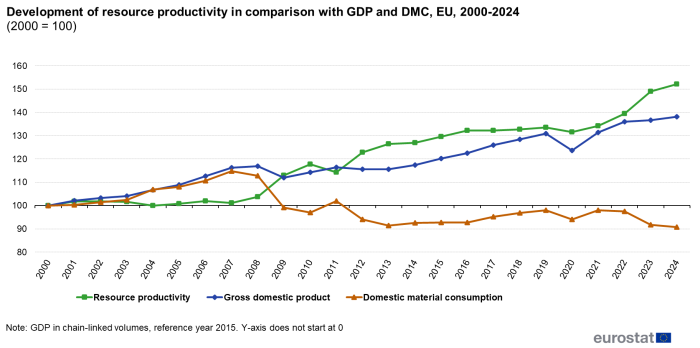
Source: Eurostat (nama_10_gdp) and (env_ac_mfa)
An analysis of the resource productivity components (see Figure 1), namely GDP and DMC, helps to explain the evolution of resource productivity over time. Before 2007-2008, GDP and DMC had been growing almost in parallel resulting in a more or less stable resource productivity. Between 2008 and 2016, the two components decoupled, i.e. developed in opposite directions. Between 2016 and 2021, both components re-couple again, i.e. show rather parallel annual change patterns. With the on-set of the recovery from the COVID-19 pandemic since 2021 we see a strong decoupling, with GDP growing by 5% from 2021 to 2024 while DMC has decreased by more than 7% over the same period.
The global financial crisis in 2007-2008 had a very different impact on the resource productivity of the EU than the COVID-19 recession. During the global financial crisis and the following years, the consumption of materials - in particular for construction, i.e. gross capital formation - dropped much more than the GDP and stayed at low levels until 2016. On the other hand, the COVID-19 pandemic caused a much more significant shrinking of the EU economy compared to the global financial crisis, while material consumption decreased moderately, in particular because the consumption of construction material and biomass almost remained unchanged. As a result, the global financial crisis triggered a significant growth in resource productivity, while the COVID-19 pandemic caused a moderate decrease, which, however, remained less pronounced than the GDP fall between 2019 and 2020.
Further information about resource productivity by country can be found in an article on resource productivity statistics. Eurostat also provides information on labour productivity in an article on national accounts and GDP.
Domestic extraction and physical trade
The material resources that enter an economy (domestic extraction and physical imports) may be used directly within the economy (domestic material consumption) or exported and used abroad. Correspondingly, DMC can be broken down into domestic extraction and the physical trade balance (imports minus exports). Physical imports and exports indicate the international role of economies in terms of resource extraction.
Figure 2 shows the development between 2000 and 2024 in the extraction of materials within the EU economy (domestic extraction), as well as physical imports and exports and the resulting physical trade balance. Notably, imports and exports are measured in the weight of products crossing the border, regardless of how much the traded goods have been processed.
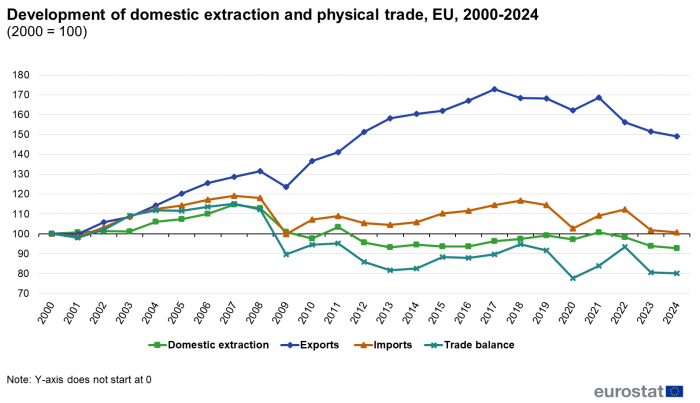
Source: Eurostat (env_ac_mfa)
The EU’s physical exports - mainly semi-manufactured and finished products - increased almost every year throughout the period 2000–2017, overall a growth of more than 70%. Since then, physical exports have been decreasing. Physical imports did not increase as much as physical exports between 2009 and 2017 and since 2018 have been decreasing as well. In 2024, the volume of imports dropped to the 2000 level, below the level of the first COVID year 2020, and more than exports. Domestic extraction of materials has remained by and large stable over the period 2000 to 2024 with a slight decrease to a level still below the 2000 level.
For more information, see the article on physical imports and exports.
Consumption by material category
An analysis of DMC by material category shows the relative significance of various materials for the economy and their potential for reuse, recovery or recycling. Materials are classified in four main categories: biomass, metal ores, non-metallic minerals and fossil energy materials. The total DMC of the EU economy was estimated at just below 13.4 tonnes per capita in 2024. The EU’s DMC was dominated by non-metallic minerals (see Figure 3), making up more than half of the total in weight. Biomass made up approximately a quarter of DMC and fossil fuels just under a fifth. Metal ores constituted the smallest of the four main material categories.
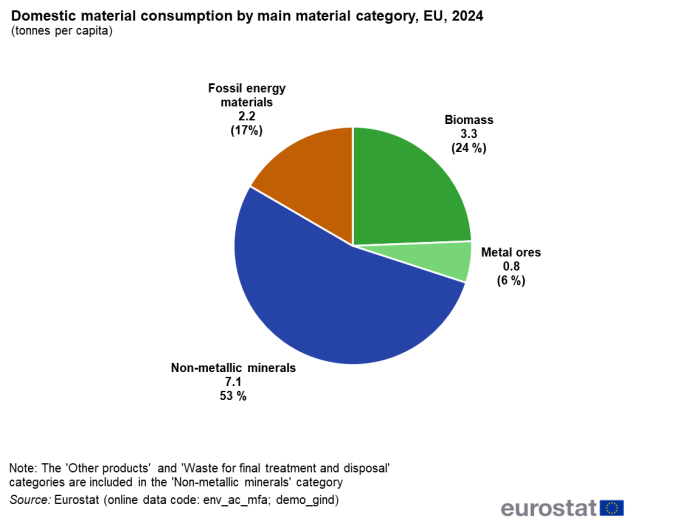
Source: Eurostat (env_ac_mfa) and (demo_gind)
The consumption patterns over time of these four main categories have varied (see Figure 4). The consumption of biomass has been on a rather stable level over the long term, but with frequent smaller annual changes. The consumption of metal ores shows a more pronounced development obviously determined by the financial and economic crisis and by the recent COVID-19 recession. The consumption of fossil energy materials shows a smooth development with a long-term downward trend - mirroring reduced CO2-emissions - and a significant drop in 2020 due to the COVID-19 recession and a next drop up to 2024 as a result of spiking energy prices caused by Russia's war of agression against Ukraine. Consumption of non-metallic minerals - quantitatively the most important component of DMC - showed a significant decline with the global financial crisis 2007-2008; since 2016, it has been distinctively increasing again. Notably, consumption of non-metallic minerals has been only mildly affected by the COVID-19 recession.
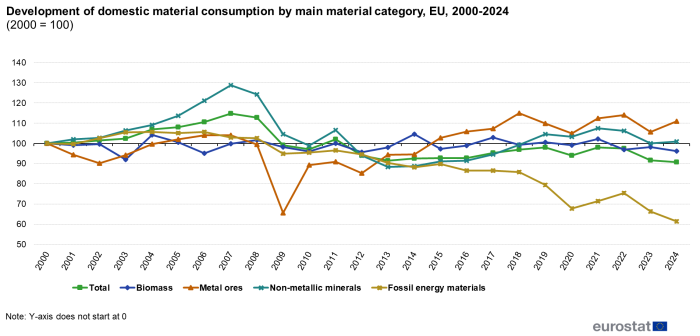
Source: Eurostat (env_ac_mfa)
Material consumption by EU countries
The level of DMC differs significantly across the EU, ranging from around 8-9 tonnes per capita (the Netherlands, Italy and Spain) to around 30-40 tonnes per capita (Romania and Finland). Furthermore, the structure of DMC - by main material category - varies across countries, as can be seen from Figure 5. The composition of DMC in each country is influenced by natural endowments with material resources, and the latter may form an important structural element of each economy.
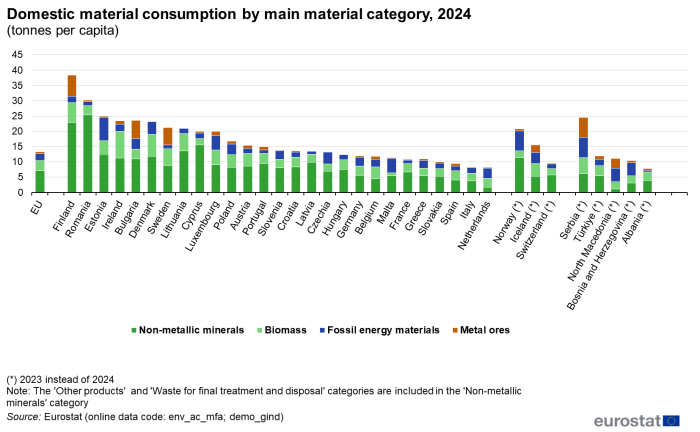
Source: Eurostat (env_ac_mfa) and (demo_gind)
The consumption of non-metallic minerals varied most across countries from around 2 tonnes per capita in the Netherlands to around 25 tonnes per capita in Romania. Here, the differences between countries are influenced, amongst others, by levels of construction activities (investments), population densities, and size of infrastructure, such as the road network. Biomass consumption also varied greatly across countries ranging between around 1 tonne per capita in Malta and around 7-8 tonnes per capita in Denmark and Ireland. Economies with high biomass consumption are specialised in timber production (Finland) or livestock production (Ireland, Denmark). Consumption of fossil energy material was around 2.2 tonnes per capita for the EU and rather even across countries.
Besides the structure of the economy and climatic conditions, population density may explain - at least in part - differences between European countries in relation to consumption patterns. More densely populated EU countries, such as the Netherlands and Belgium, tend to consume somewhat lower amounts per capita than the EU average whereas higher per capita consumption may be observed for low population density EU countries, like Finland, Estonia and Sweden.
The EU’s domestic material consumption compared with the world's material extraction
Since 2000, the DMC of the EU decreased from 15.4 to 13.4 tonnes per capita in 2024.
Worldwide material extraction - which equals the world’s DMC as the global trade balance is zero - has been steadily increasing since the year 2000 when it was at 9.5 tonnes per capita until 2014 when it reached 12.6 tonnes per capita. In the period 2014-2020 worldwide DMC has been approximately stable, while it has increased again up to 2024 reaching at 13.2 tonnes per capita the highest level since 2000, slightly below the EU average.
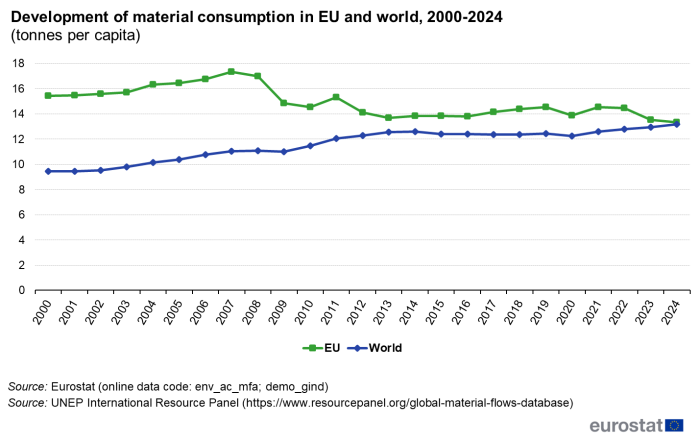
Source: Eurostat (env_ac_mfa) and (demo_gind), UNEP International Resource Panel (https://www.resourcepanel.org/global-material-flows-database)
Raw material equivalents - towards a global perspective
DMC, the main material flow indicator, can be complemented with supplementary estimates of the amount of raw materials needed to produce traded products. This element is particularly important when considering the material extractions of open economies and the effects of international trade. The amount of raw materials needed to produce traded products can be estimated by converting them into ‘raw material equivalents’. The total weight of raw material extractions needed to produce manufactured products is usually several times greater than the weight of the products themselves. Eurostat has developed a model to estimate the raw material equivalents of imports and exports for the aggregated EU economy and the results are presented in an article on material flow accounts statistics - material footprints.
Source data for tables and graphs
Data sources
The article is based on domestic material consumption and its components, as defined in material flow accounts. Eurostat’s material flow accounts are a comprehensive data framework that systematically records the inputs of materials to European economies.
Economy-wide material flow accounts (EW-MFA) are one of the European environmental economic accounts (see Regulation (EU) No 691/2011 on European environmental economic accounts).
EW-MFA provide an aggregate overview, in thousand tonnes per year, of the material flows into and out of an economy. EW-MFA cover solid, gaseous, and liquid materials, except for bulk flows of water and air. Material inputs into national economies include domestic extraction of material originating from the domestic environment and physical imports originating from other economies. Material outputs from national economies include materials released to the domestic environment (e.g. emissions to air, water and soil) and physical exports to other economies. Material flows within the economy are not represented in EW-MFA.
A variety of material flow-based indicators are derived from EW-MFA amongst which the following:
Domestic material consumption (DMC) measures the total amount, in tonnes, of material directly used in an economy, i.e. by resident businesses, governments and other institutions for economic production or by households. DMC equals the domestic extractions of materials plus imports minus exports. At the same time, DMC is the amount of materials that become part of the material stock within the economy or are released back to the environment in form of e.g. emissions to air.
Resource productivity is defined here as GDP divided by DMC. Hence, resource productivity quantifies the relation between economic activity and the consumption of natural resources, and sheds light on whether they go hand-in-hand or the extent to which they are decoupled (see definitions in the section on data sources). Natural resources include biomass, metal ores, non-metallic minerals and fossil energy materials. Resource productivity is an important indicator of the sustainable development goal 12 ‘responsible consumption and production’. It is important to note that GDP is expressed in different measurement units, of which the following are used to calculate three different resource productivity ratios. The appropriate choice depends on the context of the analysis
- euro per kilogram using chain-linked volume data for GDP, to be used for analysing developments in real terms over time
- PPS per kilogram using current price data for GDP expressed in purchasing power standards (PPS); PPS are artificial currency units that remove differences in purchasing power between economies by taking account of price level differences; these can be used when comparing across different economies at one point in time (for one particular year)
- euro per kilogram using current price data for GDP, which could be used when analysing a single economy at one point in time (for one particular year)
See also MFA metadata.
Decoupling
The term decoupling refers to breaking the link between an environmental and an economic variable. As defined by the Organisation for Economic Co-operation and Development (OECD), decoupling occurs when the growth rate of an environmental pressure (for example, DMC) is less than that of its economic driving force (for example, GDP) over a given period. Decoupling can be either absolute or relative. Absolute decoupling is said to occur when the environmental variable is stable or decreases while the economic driving force grows. Decoupling is said to be relative when the rate of change of the environmental variable is less than the rate of change of the economic variable.
Context
Eurostat's environmental accounts and statistics inform policy making under the European Commission's 2024-2029 priorities. In this context, the plan for Europe's sustainable prosperity and competitiveness works towards a more circular and resilient economy to shift to a more sustainable pattern of production and consumption, retaining the value of resources in our economy for longer.
Further reading:
Publication: A new Circular Economy Action Plan for a Cleaner and More Competitive Europe
Communication: A new Circular Economy Action Plan for a Cleaner and More Competitive Europe
Explore further
Other articles
Database
- Environment (env)
- Material flows and resource productivity (env_mrp), see:
- Material flow accounts (env_ac_mfa)
- Resource productivity (env_ac_rp)
- Circular economy, see:
- Circular economy indicators (cei)
Thematic section
Publications
Publications and EU policies' monitoring frameworks
External links
- European Commission — Environment — Circular economy
- European Environment Agency: The European environment — state and outlook 2020: knowledge for transition to a sustainable Europe SOER 2020
- OECD — Resource efficiency
